

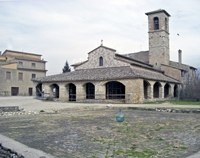
The church is named for a tablet of red marble that is now on the second pillar on the right. It seems to have come from a fountain and, according to an ancient tradition, is believed to promote fertility.
The church stands beside the line of the Roman Via Flaminia, and was probably at the heart of the colony of Trebae. Several Roman remains have been found here:
-
✴A Latin inscription (2nd century BC), which is now embedded in the wall of the left aisle of the church, celebrates "IOVI O. M." (Jove Optimus Maximus). This is one of the oldest records in Umbria of this important cult.
-
✴The remains of what might have been the baths of Roman Trebiae were visible nearby in the 15th century.
-
✴An inscription (1st century AD) found nearby in 1864 is exhibited in the Museo della Città e del Territorio
Excavations in 2005 in what is now the brick-covered area in front and to the right of the church brought to light a Lombard necropolis (6th and 7th centuries AD). A number of grave goods and the reconstructed tomb of a warrior (complete with skeleton) are exhibited in the Museo della Città e del Territorio.
Numerous fragments incorporated into the fabric of the church suggest that it stands on the site of an earlier structure. The portico around three sides of the church was added in the 15th century and the campanile in the 16th century. The roof was rebuilt after the earthquake of 1832 and the church was restored in 1946 after damage sustained in the Second World War.
The important church has been closed since the earthquake of 1997. I am very grateful to Signor Franco Spellani for providing the photographs below. There are photographs in the site of Trevi Ambiente and in an important article by Signor Spellani in this issue of “Archeo Foligno” (at page 8).
Frescoes under the Portico
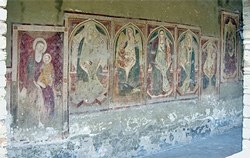
The frescoes on the right side of the portico mostly depict the Madonna and Child. Three adjacent frescoes in the series are (or were) signed by Bartolomeo da Miranda:
-
✴the Madonna and Child enthroned, with a now illegible inscription, in which the Madonna holds a pomegranate;
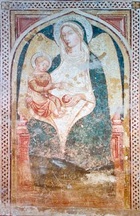
-
✴the Madonna delle Spighe (1449), which depicts the Madonna and Child enthroned, with the Virgin holding a bird and some ears of corn (“spighe”);
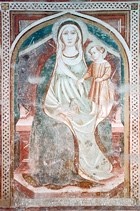
-
✴the Madonna with a fragmentary inscription “meo” and another that identifies the donor, Gacucius da Macino.
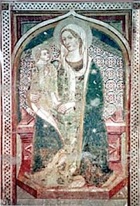
Two other Marian frescoes on the left side of the portico are dated 1484.
Frescoes in the Chapel (ca. 1510)
These very damaged frescoes in the chapel at the end of the right side of the portico (which has a small communication door into the church) are attributed to Francesco Melanzio da Montefalco. They depict:
-
✴the Crucifixion with the Virgin and St John the Evangelist, on the back wall; and
-
✴the Madonna and Child enthroned, with St Sebastian, on the right wall.
Frescoes in the Church
Frescoes on the Counter-facade (13th century)
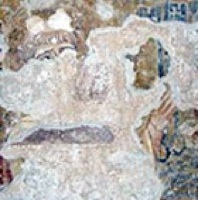
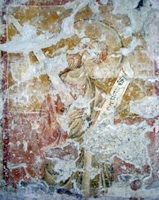
These fragments, which are the oldest in the church, depict SS Peter and Paul.
Frescoes in the Presbytery (ca. 1400)
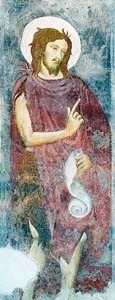
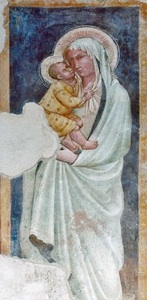
All of the surviving frescoes in the presbytery and on the arch in front of it are attributed to the Maestro della Dormitio di Terni. These frescoes, which are generally of higher quality than those elsewhere in the church, depict:
-
✴in the presbytery:
-
•the Madonna and Child with St Antony Abbot;
-
•symbols of the Evangelists (only one of which survives); and
-
•St Joachim (the father of the Virgin) driven from the Temple (to the left): and
-
✴on the arch:
-
•St John the Baptist (illustrated above);
-
•St Elizabeth and another saint; and
-
•a beautiful standing figure of the Madonna and Child (also illustrated above).
Madonna dell’ Abbecedario (15th century)
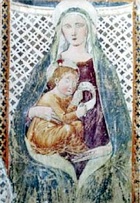
Frescoes on the Left Wall (15th century)
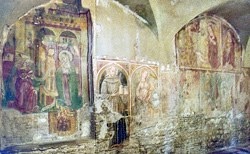
These include:
-
✴the Annunciation (1477), signed by Valerio de’ Muti and dated by inscription, which also records the donor, “Marino de Parmaciu de Gironimo da Matigia” (illustrated above and to the right here, above a fresco of St Christopher);
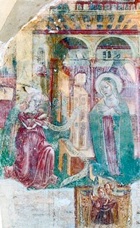
-
✴another Annunciation (1435) in the adjacent bay, which appears next to a Madonna and Child, with an inscription that gives the date and the name of the donor, Nicolaus.
The frescoes in the first two bays of this wall, which are attributed to the Maestro di Eggi, depict:
-
✴in the first bay:
-
•the four Evangelists (in the vaults);
-
•the Madonna and Child with St James;
-
•mystical marriage of St Catherine;
-
•the Way to Calvary;
-
•the Annunciation; and
-
•Christ’s agony at Gethsemane.
-
✴in the second bay:
-
•Christ the Redeemer, which is very damaged (in the vaults);
-
•the Madonna and Child with SS Antony Abbot and Leonard (above); and
-
•SS Lucy, Elizabeth and Christopher.
Frescoes on the Right Wall (15th century)
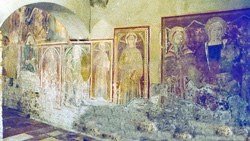
Three frescoes on the right wall are signed by Bartolomeo da Miranda:
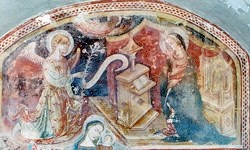
-
✴the Annunciation (illustrated above); and
-
✴two of the three frescoes below it of the Madonna and Child:
-
•the Madonna and Child enthroned; and
-
•the Madonna and Child in which the baby Jesus holds an apple (illustrated here).
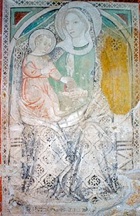
Tabernacle (16th century)
This carved marble tabernacle, which is attributed to Rocco di Tommaso da Vicenza, is on the 2nd pillar on the right (on which is the “pietra rossa”). The subjects depicted are:
-
✴the Madonna and Child, in polychrome relief, with God the Father and angels above; and
-
✴statues in niches of:
-
•St Emilianus; and
-
•St John the Baptist.
Art from the Church
SS Peter and Paul (1663)
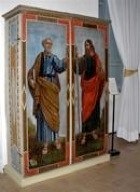
The figures displayed (SS Peter and Paul) were originally on the inside of the doors, and thus stood to the sides of the Crucifix when the tabernacle was open for liturgical purposes. It was more normally closed, when the figures of SS Emilian and John the Baptist on the outer doors were displayed.
The panel of St Peter is signed by Giovanni Giacomo Tobiolo (from Urbino), and dated.

